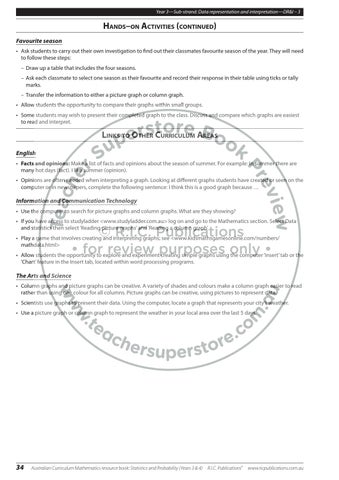Year 3—Sub-strand: Data representation and interpretation—DR&I – 3
HANDS–ON ACTIVITIES (CONTINUED) Favourite season • Ask students to carry out their own investigation to find out their classmates favourite season of the year. They will need to follow these steps: – Draw up a table that includes the four seasons. – Ask each classmate to select one season as their favourite and record their response in their table using ticks or tally marks. – Transfer the information to either a picture graph or column graph. • Allow students the opportunity to compare their graphs within small groups. • Some students may wish to present their completed graph to the class. Discuss and compare which graphs are easiest to read and interpret.
LINKS TO OTHER CURRICULUM AREAS English • Facts and opinions: Make a list of facts and opinions about the season of summer. For example: In summer there are many hot days (fact). I like summer (opinion). • Opinions are often needed when interpreting a graph. Looking at different graphs students have created or seen on the computer or in newspapers, complete the following sentence: I think this is a good graph because …
Information and Communication Technology • Use the computer to search for picture graphs and column graphs. What are they showing? • If you have access to studyladder <www.studyladder.com.au> log on and go to the Mathematics section. Select Data and statistics then select ‘Reading picture graphs’ and ‘Reading a column graph’. • Play a game that involves creating and interpreting graphs; see <www.kidsmathsgamesonline.com/numbers/ mathdata.html> • Allow students the opportunity to explore and experiment creating simple graphs using the computer ‘Insert’ tab or the ‘Chart’ feature in the Insert tab, located within word processing programs.
The Arts and Science • Column graphs and picture graphs can be creative. A variety of shades and colours make a column graph easier to read rather than using one colour for all columns. Picture graphs can be creative, using pictures to represent data. • Scientists use graphs to present their data. Using the computer, locate a graph that represents your city’s weather. • Use a picture graph or column graph to represent the weather in your local area over the last 5 days.
34
Australian Curriculum Mathematics resource book: Statistics and Probability (Years 3 & 4)
R.I.C. Publications® www.ricpublications.com.au
